Kier Group Leadership Assignment: Understanding Leadership Styles
VerifiedAdded on 2022/10/12
|28
|7862
|18
Homework Assignment
AI Summary
This assignment delves into the multifaceted aspects of leadership, focusing on how various factors influence leadership styles and behaviors within a workplace setting. The student explores the impact of factors such as workplace structure, team efficiency, organizational culture, and technology on leadership choices. The assignment examines how these factors can lead to the adoption of different leadership styles, including autocratic, democratic, and bureaucratic approaches. It also analyzes the influence of these styles on individual and team behaviors, highlighting both the positive and negative impacts. Furthermore, the assignment discusses how technology is transforming leadership, emphasizing the need for leaders to adapt to new communication methods and technological advancements. The student provides examples and insights to illustrate the practical application of leadership theories and models in real-world scenarios, aiming to enhance leadership skills and effectiveness.
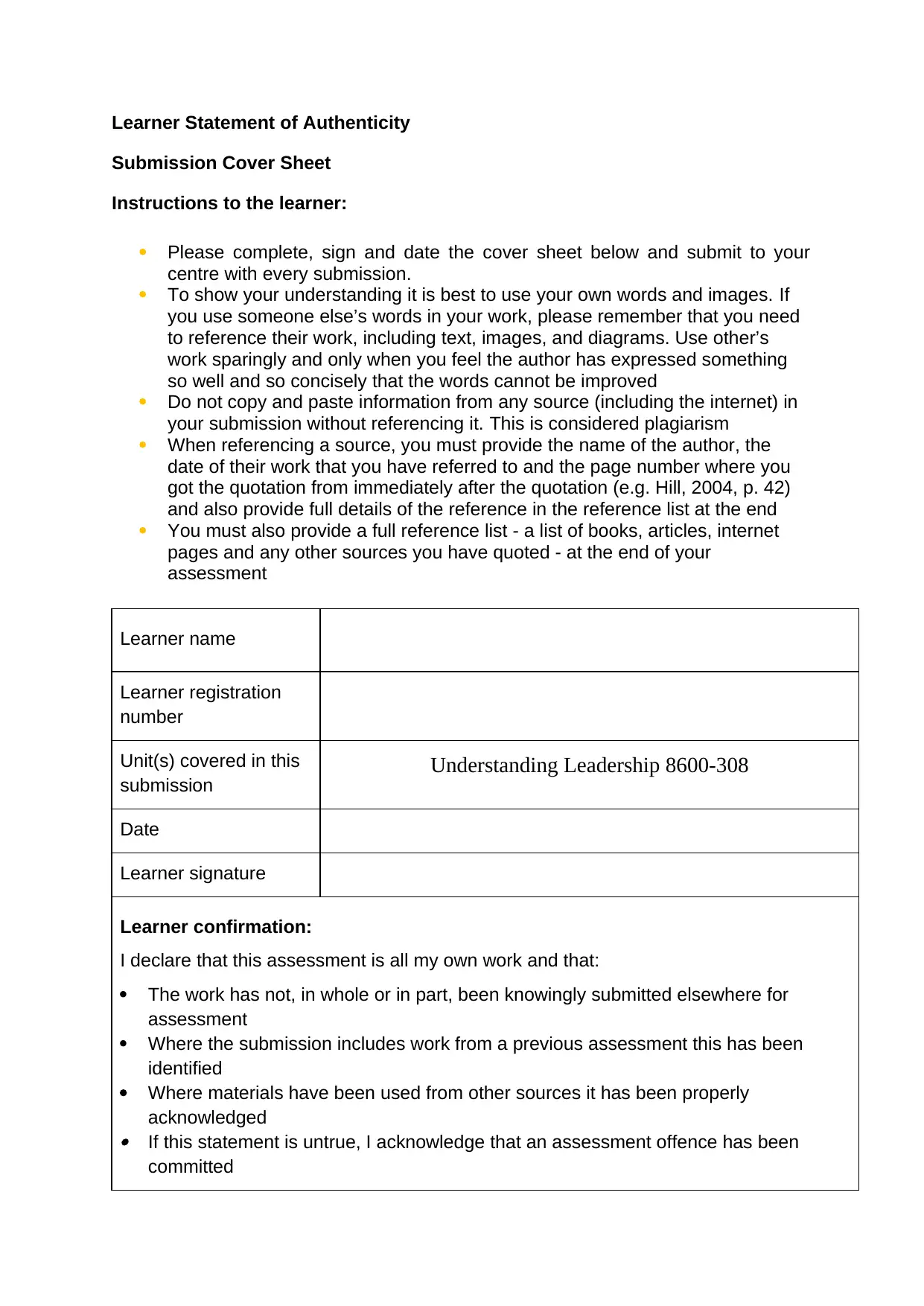
Learner Statement of Authenticity
Submission Cover Sheet
Instructions to the learner:
Please complete, sign and date the cover sheet below and submit to your
centre with every submission.
To show your understanding it is best to use your own words and images. If
you use someone else’s words in your work, please remember that you need
to reference their work, including text, images, and diagrams. Use other’s
work sparingly and only when you feel the author has expressed something
so well and so concisely that the words cannot be improved
Do not copy and paste information from any source (including the internet) in
your submission without referencing it. This is considered plagiarism
When referencing a source, you must provide the name of the author, the
date of their work that you have referred to and the page number where you
got the quotation from immediately after the quotation (e.g. Hill, 2004, p. 42)
and also provide full details of the reference in the reference list at the end
You must also provide a full reference list - a list of books, articles, internet
pages and any other sources you have quoted - at the end of your
assessment
Learner name
Learner registration
number
Unit(s) covered in this
submission
Understanding Leadership 8600-308
Date
Learner signature
Learner confirmation:
I declare that this assessment is all my own work and that:
The work has not, in whole or in part, been knowingly submitted elsewhere for
assessment
Where the submission includes work from a previous assessment this has been
identified
Where materials have been used from other sources it has been properly
acknowledged If this statement is untrue, I acknowledge that an assessment offence has been
committed
Submission Cover Sheet
Instructions to the learner:
Please complete, sign and date the cover sheet below and submit to your
centre with every submission.
To show your understanding it is best to use your own words and images. If
you use someone else’s words in your work, please remember that you need
to reference their work, including text, images, and diagrams. Use other’s
work sparingly and only when you feel the author has expressed something
so well and so concisely that the words cannot be improved
Do not copy and paste information from any source (including the internet) in
your submission without referencing it. This is considered plagiarism
When referencing a source, you must provide the name of the author, the
date of their work that you have referred to and the page number where you
got the quotation from immediately after the quotation (e.g. Hill, 2004, p. 42)
and also provide full details of the reference in the reference list at the end
You must also provide a full reference list - a list of books, articles, internet
pages and any other sources you have quoted - at the end of your
assessment
Learner name
Learner registration
number
Unit(s) covered in this
submission
Understanding Leadership 8600-308
Date
Learner signature
Learner confirmation:
I declare that this assessment is all my own work and that:
The work has not, in whole or in part, been knowingly submitted elsewhere for
assessment
Where the submission includes work from a previous assessment this has been
identified
Where materials have been used from other sources it has been properly
acknowledged If this statement is untrue, I acknowledge that an assessment offence has been
committed
Paraphrase This Document
Need a fresh take? Get an instant paraphrase of this document with our AI Paraphraser
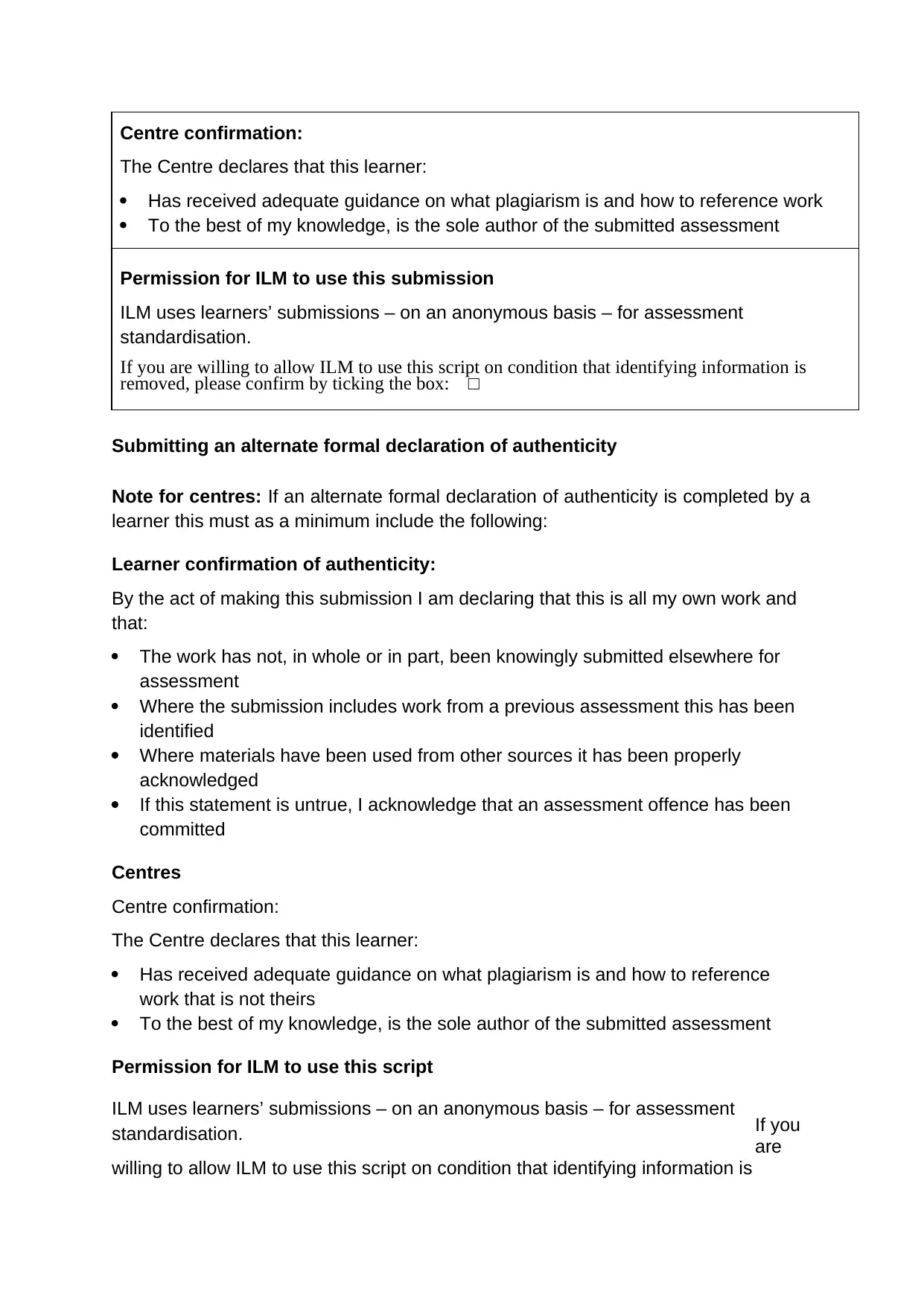
Centre confirmation:
The Centre declares that this learner:
Has received adequate guidance on what plagiarism is and how to reference work
To the best of my knowledge, is the sole author of the submitted assessment
Permission for ILM to use this submission
ILM uses learners’ submissions – on an anonymous basis – for assessment
standardisation.
If you are willing to allow ILM to use this script on condition that identifying information is
removed, please confirm by ticking the box: □
Submitting an alternate formal declaration of authenticity
Note for centres: If an alternate formal declaration of authenticity is completed by a
learner this must as a minimum include the following:
Learner confirmation of authenticity:
By the act of making this submission I am declaring that this is all my own work and
that:
The work has not, in whole or in part, been knowingly submitted elsewhere for
assessment
Where the submission includes work from a previous assessment this has been
identified
Where materials have been used from other sources it has been properly
acknowledged
If this statement is untrue, I acknowledge that an assessment offence has been
committed
Centres
Centre confirmation:
The Centre declares that this learner:
Has received adequate guidance on what plagiarism is and how to reference
work that is not theirs
To the best of my knowledge, is the sole author of the submitted assessment
Permission for ILM to use this script
If you
are
willing to allow ILM to use this script on condition that identifying information is
ILM uses learners’ submissions – on an anonymous basis – for assessment
standardisation.
The Centre declares that this learner:
Has received adequate guidance on what plagiarism is and how to reference work
To the best of my knowledge, is the sole author of the submitted assessment
Permission for ILM to use this submission
ILM uses learners’ submissions – on an anonymous basis – for assessment
standardisation.
If you are willing to allow ILM to use this script on condition that identifying information is
removed, please confirm by ticking the box: □
Submitting an alternate formal declaration of authenticity
Note for centres: If an alternate formal declaration of authenticity is completed by a
learner this must as a minimum include the following:
Learner confirmation of authenticity:
By the act of making this submission I am declaring that this is all my own work and
that:
The work has not, in whole or in part, been knowingly submitted elsewhere for
assessment
Where the submission includes work from a previous assessment this has been
identified
Where materials have been used from other sources it has been properly
acknowledged
If this statement is untrue, I acknowledge that an assessment offence has been
committed
Centres
Centre confirmation:
The Centre declares that this learner:
Has received adequate guidance on what plagiarism is and how to reference
work that is not theirs
To the best of my knowledge, is the sole author of the submitted assessment
Permission for ILM to use this script
If you
are
willing to allow ILM to use this script on condition that identifying information is
ILM uses learners’ submissions – on an anonymous basis – for assessment
standardisation.
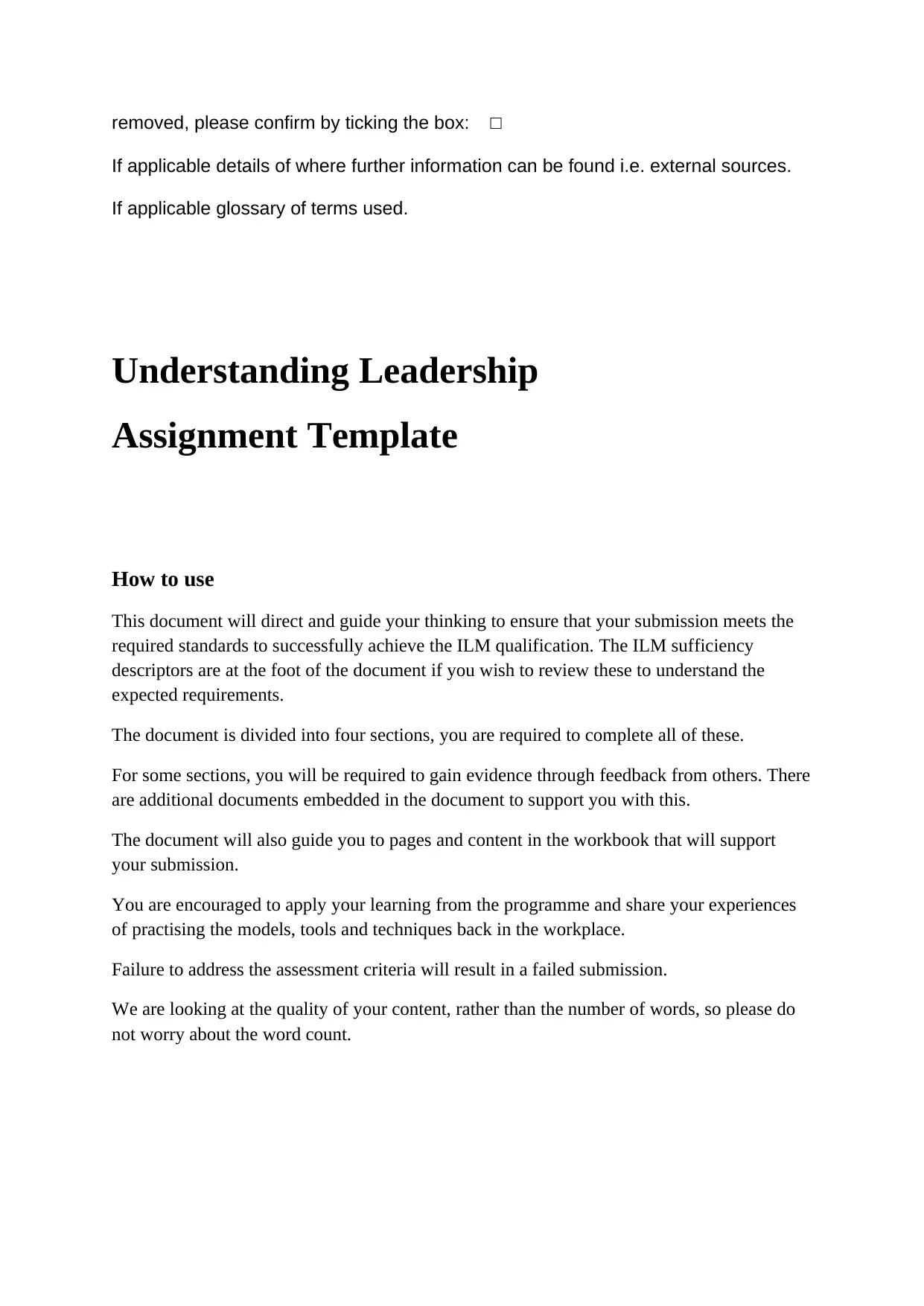
removed, please confirm by ticking the box: □
If applicable details of where further information can be found i.e. external sources.
If applicable glossary of terms used.
Understanding Leadership
Assignment Template
How to use
This document will direct and guide your thinking to ensure that your submission meets the
required standards to successfully achieve the ILM qualification. The ILM sufficiency
descriptors are at the foot of the document if you wish to review these to understand the
expected requirements.
The document is divided into four sections, you are required to complete all of these.
For some sections, you will be required to gain evidence through feedback from others. There
are additional documents embedded in the document to support you with this.
The document will also guide you to pages and content in the workbook that will support
your submission.
You are encouraged to apply your learning from the programme and share your experiences
of practising the models, tools and techniques back in the workplace.
Failure to address the assessment criteria will result in a failed submission.
We are looking at the quality of your content, rather than the number of words, so please do
not worry about the word count.
If applicable details of where further information can be found i.e. external sources.
If applicable glossary of terms used.
Understanding Leadership
Assignment Template
How to use
This document will direct and guide your thinking to ensure that your submission meets the
required standards to successfully achieve the ILM qualification. The ILM sufficiency
descriptors are at the foot of the document if you wish to review these to understand the
expected requirements.
The document is divided into four sections, you are required to complete all of these.
For some sections, you will be required to gain evidence through feedback from others. There
are additional documents embedded in the document to support you with this.
The document will also guide you to pages and content in the workbook that will support
your submission.
You are encouraged to apply your learning from the programme and share your experiences
of practising the models, tools and techniques back in the workplace.
Failure to address the assessment criteria will result in a failed submission.
We are looking at the quality of your content, rather than the number of words, so please do
not worry about the word count.
⊘ This is a preview!⊘
Do you want full access?
Subscribe today to unlock all pages.

Trusted by 1+ million students worldwide
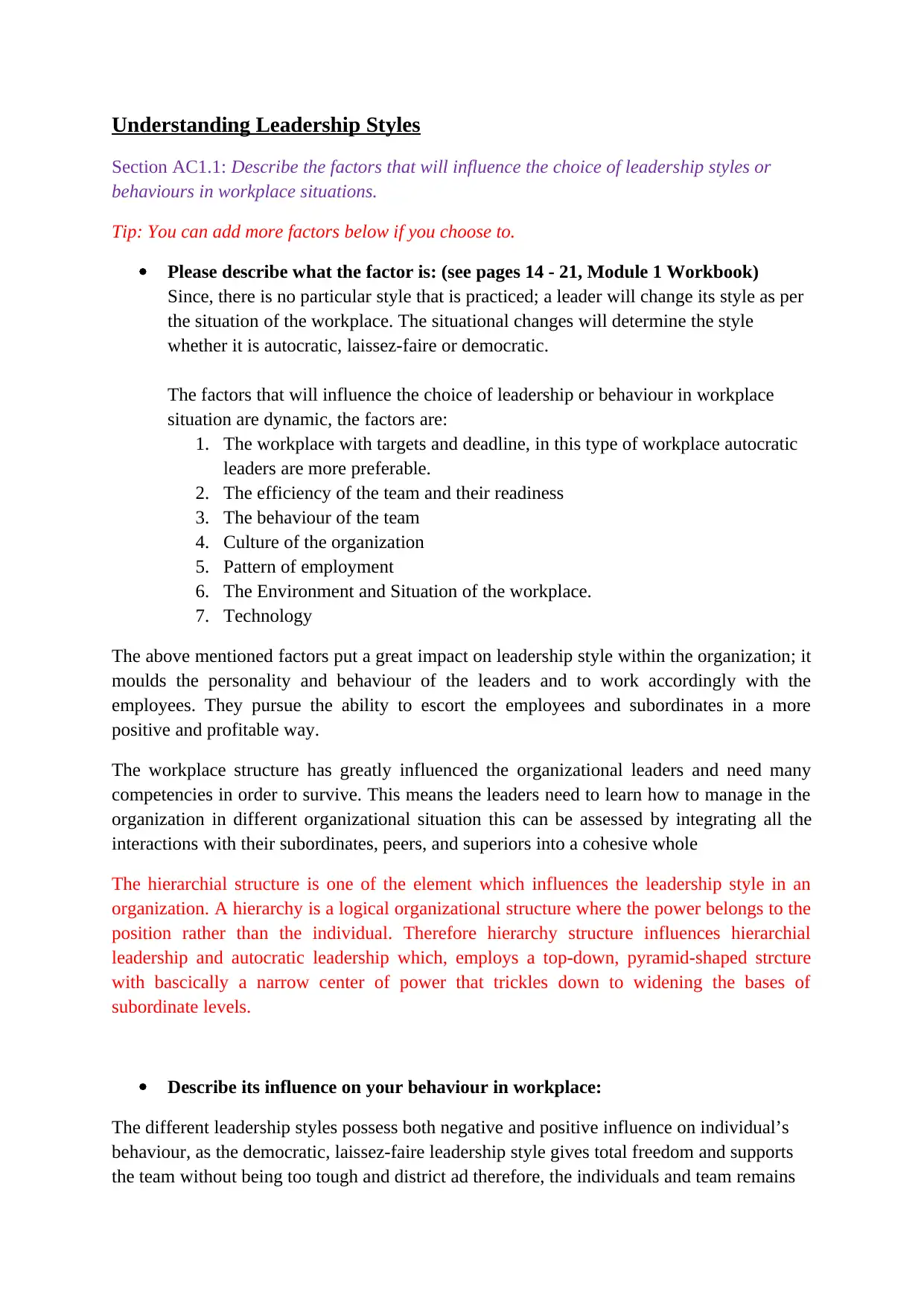
Understanding Leadership Styles
Section AC1.1: Describe the factors that will influence the choice of leadership styles or
behaviours in workplace situations.
Tip: You can add more factors below if you choose to.
Please describe what the factor is: (see pages 14 - 21, Module 1 Workbook)
Since, there is no particular style that is practiced; a leader will change its style as per
the situation of the workplace. The situational changes will determine the style
whether it is autocratic, laissez-faire or democratic.
The factors that will influence the choice of leadership or behaviour in workplace
situation are dynamic, the factors are:
1. The workplace with targets and deadline, in this type of workplace autocratic
leaders are more preferable.
2. The efficiency of the team and their readiness
3. The behaviour of the team
4. Culture of the organization
5. Pattern of employment
6. The Environment and Situation of the workplace.
7. Technology
The above mentioned factors put a great impact on leadership style within the organization; it
moulds the personality and behaviour of the leaders and to work accordingly with the
employees. They pursue the ability to escort the employees and subordinates in a more
positive and profitable way.
The workplace structure has greatly influenced the organizational leaders and need many
competencies in order to survive. This means the leaders need to learn how to manage in the
organization in different organizational situation this can be assessed by integrating all the
interactions with their subordinates, peers, and superiors into a cohesive whole
The hierarchial structure is one of the element which influences the leadership style in an
organization. A hierarchy is a logical organizational structure where the power belongs to the
position rather than the individual. Therefore hierarchy structure influences hierarchial
leadership and autocratic leadership which, employs a top-down, pyramid-shaped strcture
with bascically a narrow center of power that trickles down to widening the bases of
subordinate levels.
Describe its influence on your behaviour in workplace:
The different leadership styles possess both negative and positive influence on individual’s
behaviour, as the democratic, laissez-faire leadership style gives total freedom and supports
the team without being too tough and district ad therefore, the individuals and team remains
Section AC1.1: Describe the factors that will influence the choice of leadership styles or
behaviours in workplace situations.
Tip: You can add more factors below if you choose to.
Please describe what the factor is: (see pages 14 - 21, Module 1 Workbook)
Since, there is no particular style that is practiced; a leader will change its style as per
the situation of the workplace. The situational changes will determine the style
whether it is autocratic, laissez-faire or democratic.
The factors that will influence the choice of leadership or behaviour in workplace
situation are dynamic, the factors are:
1. The workplace with targets and deadline, in this type of workplace autocratic
leaders are more preferable.
2. The efficiency of the team and their readiness
3. The behaviour of the team
4. Culture of the organization
5. Pattern of employment
6. The Environment and Situation of the workplace.
7. Technology
The above mentioned factors put a great impact on leadership style within the organization; it
moulds the personality and behaviour of the leaders and to work accordingly with the
employees. They pursue the ability to escort the employees and subordinates in a more
positive and profitable way.
The workplace structure has greatly influenced the organizational leaders and need many
competencies in order to survive. This means the leaders need to learn how to manage in the
organization in different organizational situation this can be assessed by integrating all the
interactions with their subordinates, peers, and superiors into a cohesive whole
The hierarchial structure is one of the element which influences the leadership style in an
organization. A hierarchy is a logical organizational structure where the power belongs to the
position rather than the individual. Therefore hierarchy structure influences hierarchial
leadership and autocratic leadership which, employs a top-down, pyramid-shaped strcture
with bascically a narrow center of power that trickles down to widening the bases of
subordinate levels.
Describe its influence on your behaviour in workplace:
The different leadership styles possess both negative and positive influence on individual’s
behaviour, as the democratic, laissez-faire leadership style gives total freedom and supports
the team without being too tough and district ad therefore, the individuals and team remains
Paraphrase This Document
Need a fresh take? Get an instant paraphrase of this document with our AI Paraphraser
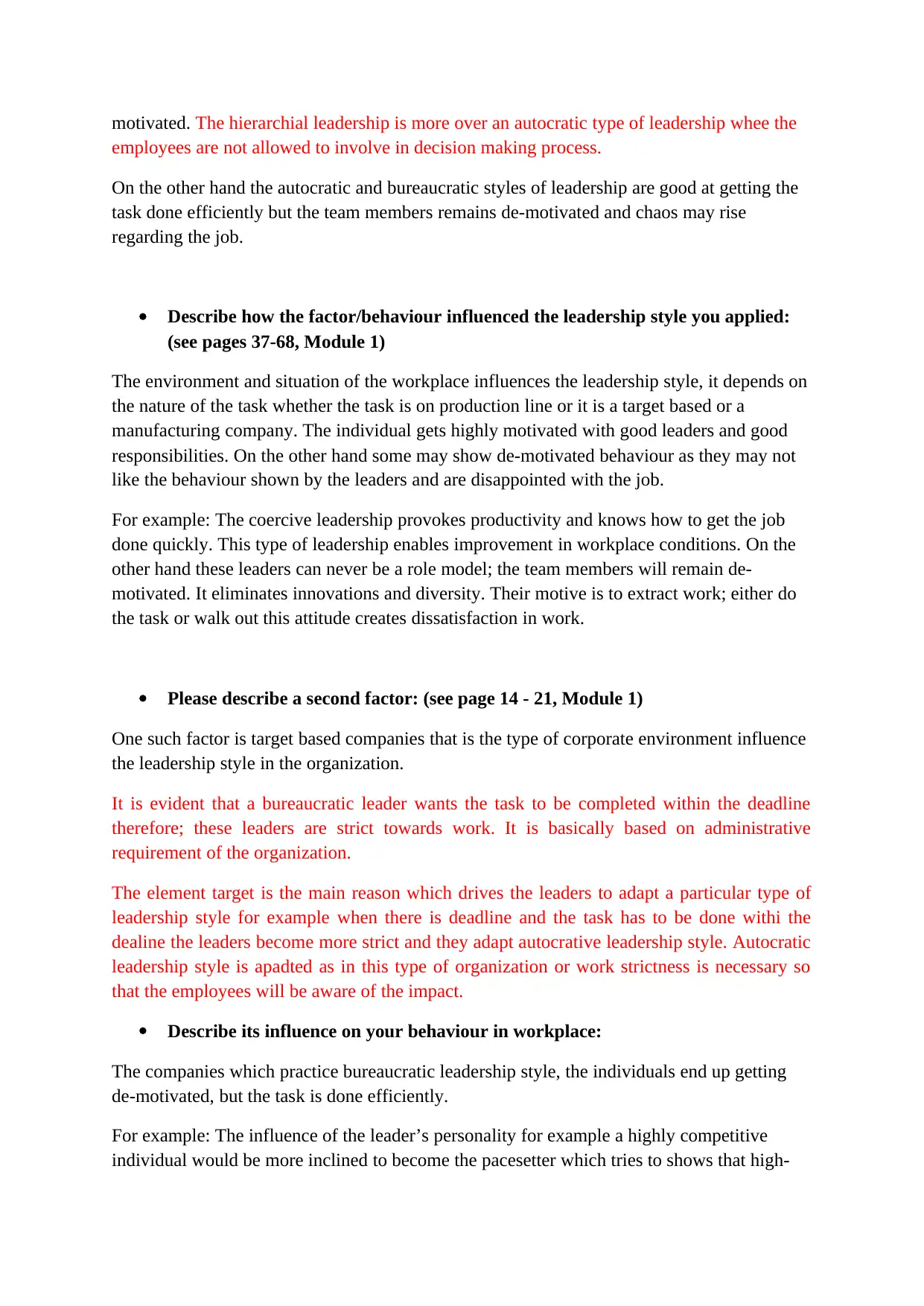
motivated. The hierarchial leadership is more over an autocratic type of leadership whee the
employees are not allowed to involve in decision making process.
On the other hand the autocratic and bureaucratic styles of leadership are good at getting the
task done efficiently but the team members remains de-motivated and chaos may rise
regarding the job.
Describe how the factor/behaviour influenced the leadership style you applied:
(see pages 37-68, Module 1)
The environment and situation of the workplace influences the leadership style, it depends on
the nature of the task whether the task is on production line or it is a target based or a
manufacturing company. The individual gets highly motivated with good leaders and good
responsibilities. On the other hand some may show de-motivated behaviour as they may not
like the behaviour shown by the leaders and are disappointed with the job.
For example: The coercive leadership provokes productivity and knows how to get the job
done quickly. This type of leadership enables improvement in workplace conditions. On the
other hand these leaders can never be a role model; the team members will remain de-
motivated. It eliminates innovations and diversity. Their motive is to extract work; either do
the task or walk out this attitude creates dissatisfaction in work.
Please describe a second factor: (see page 14 - 21, Module 1)
One such factor is target based companies that is the type of corporate environment influence
the leadership style in the organization.
It is evident that a bureaucratic leader wants the task to be completed within the deadline
therefore; these leaders are strict towards work. It is basically based on administrative
requirement of the organization.
The element target is the main reason which drives the leaders to adapt a particular type of
leadership style for example when there is deadline and the task has to be done withi the
dealine the leaders become more strict and they adapt autocrative leadership style. Autocratic
leadership style is apadted as in this type of organization or work strictness is necessary so
that the employees will be aware of the impact.
Describe its influence on your behaviour in workplace:
The companies which practice bureaucratic leadership style, the individuals end up getting
de-motivated, but the task is done efficiently.
For example: The influence of the leader’s personality for example a highly competitive
individual would be more inclined to become the pacesetter which tries to shows that high-
employees are not allowed to involve in decision making process.
On the other hand the autocratic and bureaucratic styles of leadership are good at getting the
task done efficiently but the team members remains de-motivated and chaos may rise
regarding the job.
Describe how the factor/behaviour influenced the leadership style you applied:
(see pages 37-68, Module 1)
The environment and situation of the workplace influences the leadership style, it depends on
the nature of the task whether the task is on production line or it is a target based or a
manufacturing company. The individual gets highly motivated with good leaders and good
responsibilities. On the other hand some may show de-motivated behaviour as they may not
like the behaviour shown by the leaders and are disappointed with the job.
For example: The coercive leadership provokes productivity and knows how to get the job
done quickly. This type of leadership enables improvement in workplace conditions. On the
other hand these leaders can never be a role model; the team members will remain de-
motivated. It eliminates innovations and diversity. Their motive is to extract work; either do
the task or walk out this attitude creates dissatisfaction in work.
Please describe a second factor: (see page 14 - 21, Module 1)
One such factor is target based companies that is the type of corporate environment influence
the leadership style in the organization.
It is evident that a bureaucratic leader wants the task to be completed within the deadline
therefore; these leaders are strict towards work. It is basically based on administrative
requirement of the organization.
The element target is the main reason which drives the leaders to adapt a particular type of
leadership style for example when there is deadline and the task has to be done withi the
dealine the leaders become more strict and they adapt autocrative leadership style. Autocratic
leadership style is apadted as in this type of organization or work strictness is necessary so
that the employees will be aware of the impact.
Describe its influence on your behaviour in workplace:
The companies which practice bureaucratic leadership style, the individuals end up getting
de-motivated, but the task is done efficiently.
For example: The influence of the leader’s personality for example a highly competitive
individual would be more inclined to become the pacesetter which tries to shows that high-
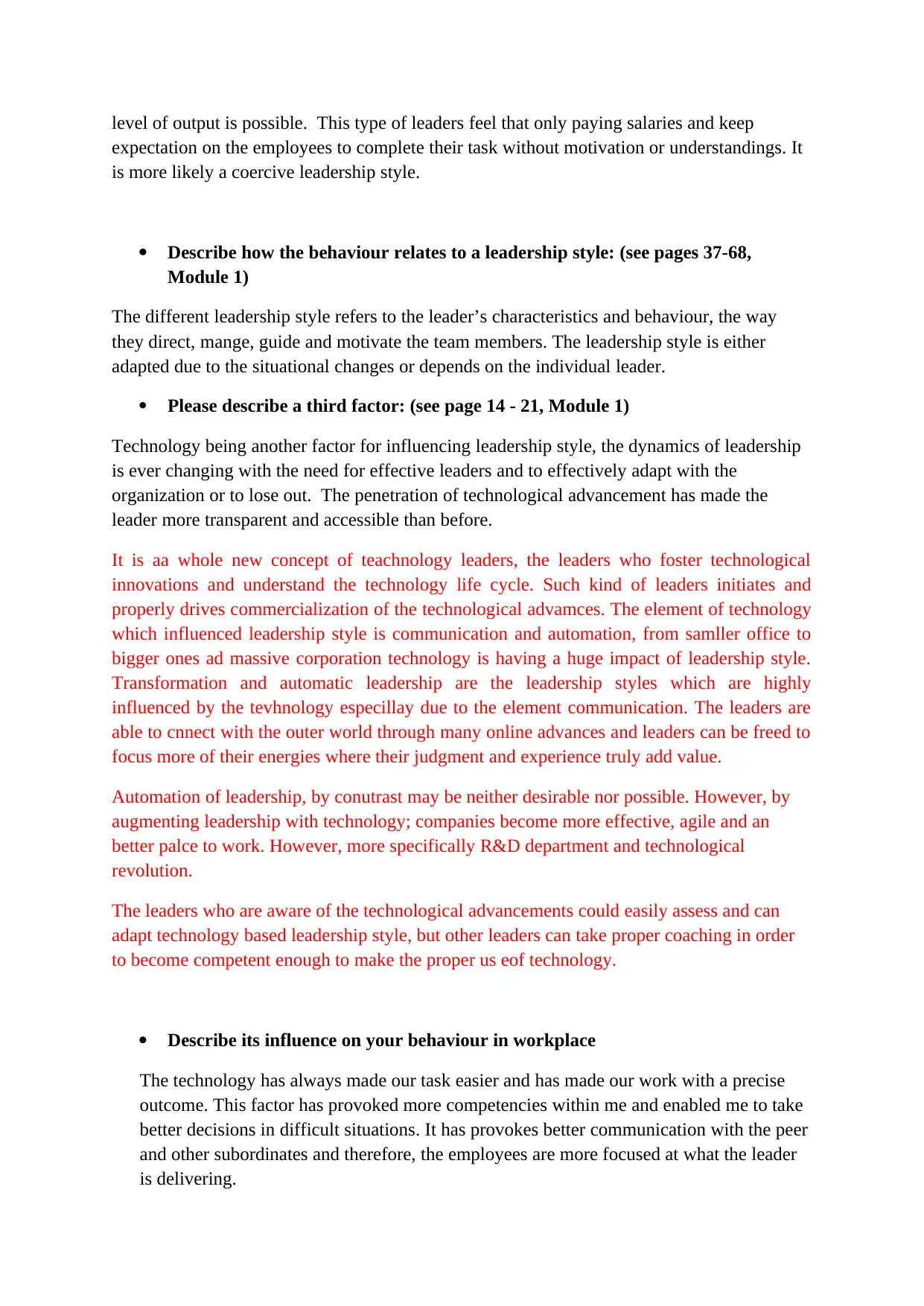
level of output is possible. This type of leaders feel that only paying salaries and keep
expectation on the employees to complete their task without motivation or understandings. It
is more likely a coercive leadership style.
Describe how the behaviour relates to a leadership style: (see pages 37-68,
Module 1)
The different leadership style refers to the leader’s characteristics and behaviour, the way
they direct, mange, guide and motivate the team members. The leadership style is either
adapted due to the situational changes or depends on the individual leader.
Please describe a third factor: (see page 14 - 21, Module 1)
Technology being another factor for influencing leadership style, the dynamics of leadership
is ever changing with the need for effective leaders and to effectively adapt with the
organization or to lose out. The penetration of technological advancement has made the
leader more transparent and accessible than before.
It is aa whole new concept of teachnology leaders, the leaders who foster technological
innovations and understand the technology life cycle. Such kind of leaders initiates and
properly drives commercialization of the technological advamces. The element of technology
which influenced leadership style is communication and automation, from samller office to
bigger ones ad massive corporation technology is having a huge impact of leadership style.
Transformation and automatic leadership are the leadership styles which are highly
influenced by the tevhnology especillay due to the element communication. The leaders are
able to cnnect with the outer world through many online advances and leaders can be freed to
focus more of their energies where their judgment and experience truly add value.
Automation of leadership, by conutrast may be neither desirable nor possible. However, by
augmenting leadership with technology; companies become more effective, agile and an
better palce to work. However, more specifically R&D department and technological
revolution.
The leaders who are aware of the technological advancements could easily assess and can
adapt technology based leadership style, but other leaders can take proper coaching in order
to become competent enough to make the proper us eof technology.
Describe its influence on your behaviour in workplace
The technology has always made our task easier and has made our work with a precise
outcome. This factor has provoked more competencies within me and enabled me to take
better decisions in difficult situations. It has provokes better communication with the peer
and other subordinates and therefore, the employees are more focused at what the leader
is delivering.
expectation on the employees to complete their task without motivation or understandings. It
is more likely a coercive leadership style.
Describe how the behaviour relates to a leadership style: (see pages 37-68,
Module 1)
The different leadership style refers to the leader’s characteristics and behaviour, the way
they direct, mange, guide and motivate the team members. The leadership style is either
adapted due to the situational changes or depends on the individual leader.
Please describe a third factor: (see page 14 - 21, Module 1)
Technology being another factor for influencing leadership style, the dynamics of leadership
is ever changing with the need for effective leaders and to effectively adapt with the
organization or to lose out. The penetration of technological advancement has made the
leader more transparent and accessible than before.
It is aa whole new concept of teachnology leaders, the leaders who foster technological
innovations and understand the technology life cycle. Such kind of leaders initiates and
properly drives commercialization of the technological advamces. The element of technology
which influenced leadership style is communication and automation, from samller office to
bigger ones ad massive corporation technology is having a huge impact of leadership style.
Transformation and automatic leadership are the leadership styles which are highly
influenced by the tevhnology especillay due to the element communication. The leaders are
able to cnnect with the outer world through many online advances and leaders can be freed to
focus more of their energies where their judgment and experience truly add value.
Automation of leadership, by conutrast may be neither desirable nor possible. However, by
augmenting leadership with technology; companies become more effective, agile and an
better palce to work. However, more specifically R&D department and technological
revolution.
The leaders who are aware of the technological advancements could easily assess and can
adapt technology based leadership style, but other leaders can take proper coaching in order
to become competent enough to make the proper us eof technology.
Describe its influence on your behaviour in workplace
The technology has always made our task easier and has made our work with a precise
outcome. This factor has provoked more competencies within me and enabled me to take
better decisions in difficult situations. It has provokes better communication with the peer
and other subordinates and therefore, the employees are more focused at what the leader
is delivering.
⊘ This is a preview!⊘
Do you want full access?
Subscribe today to unlock all pages.

Trusted by 1+ million students worldwide
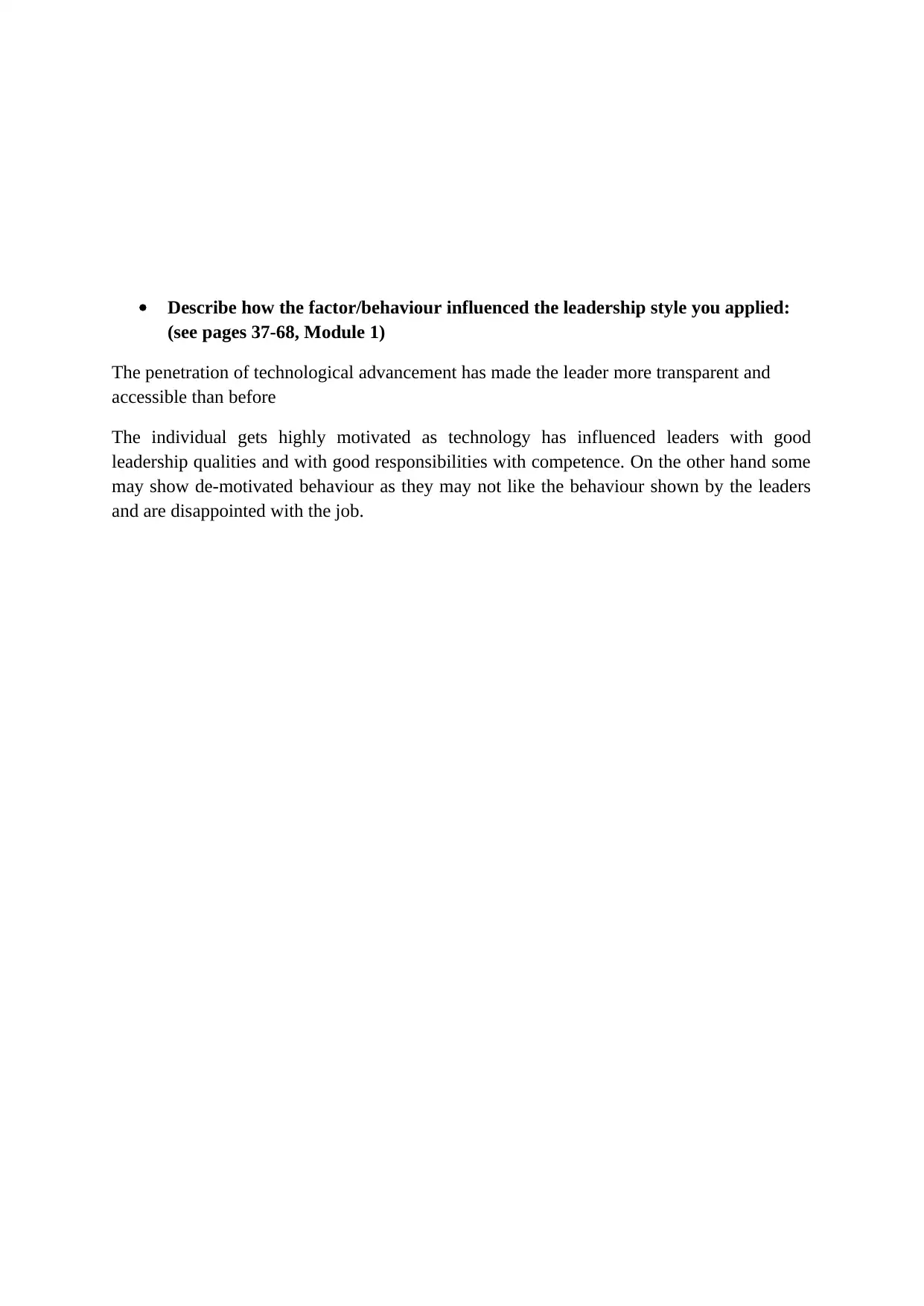
Describe how the factor/behaviour influenced the leadership style you applied:
(see pages 37-68, Module 1)
The penetration of technological advancement has made the leader more transparent and
accessible than before
The individual gets highly motivated as technology has influenced leaders with good
leadership qualities and with good responsibilities with competence. On the other hand some
may show de-motivated behaviour as they may not like the behaviour shown by the leaders
and are disappointed with the job.
(see pages 37-68, Module 1)
The penetration of technological advancement has made the leader more transparent and
accessible than before
The individual gets highly motivated as technology has influenced leaders with good
leadership qualities and with good responsibilities with competence. On the other hand some
may show de-motivated behaviour as they may not like the behaviour shown by the leaders
and are disappointed with the job.
Paraphrase This Document
Need a fresh take? Get an instant paraphrase of this document with our AI Paraphraser
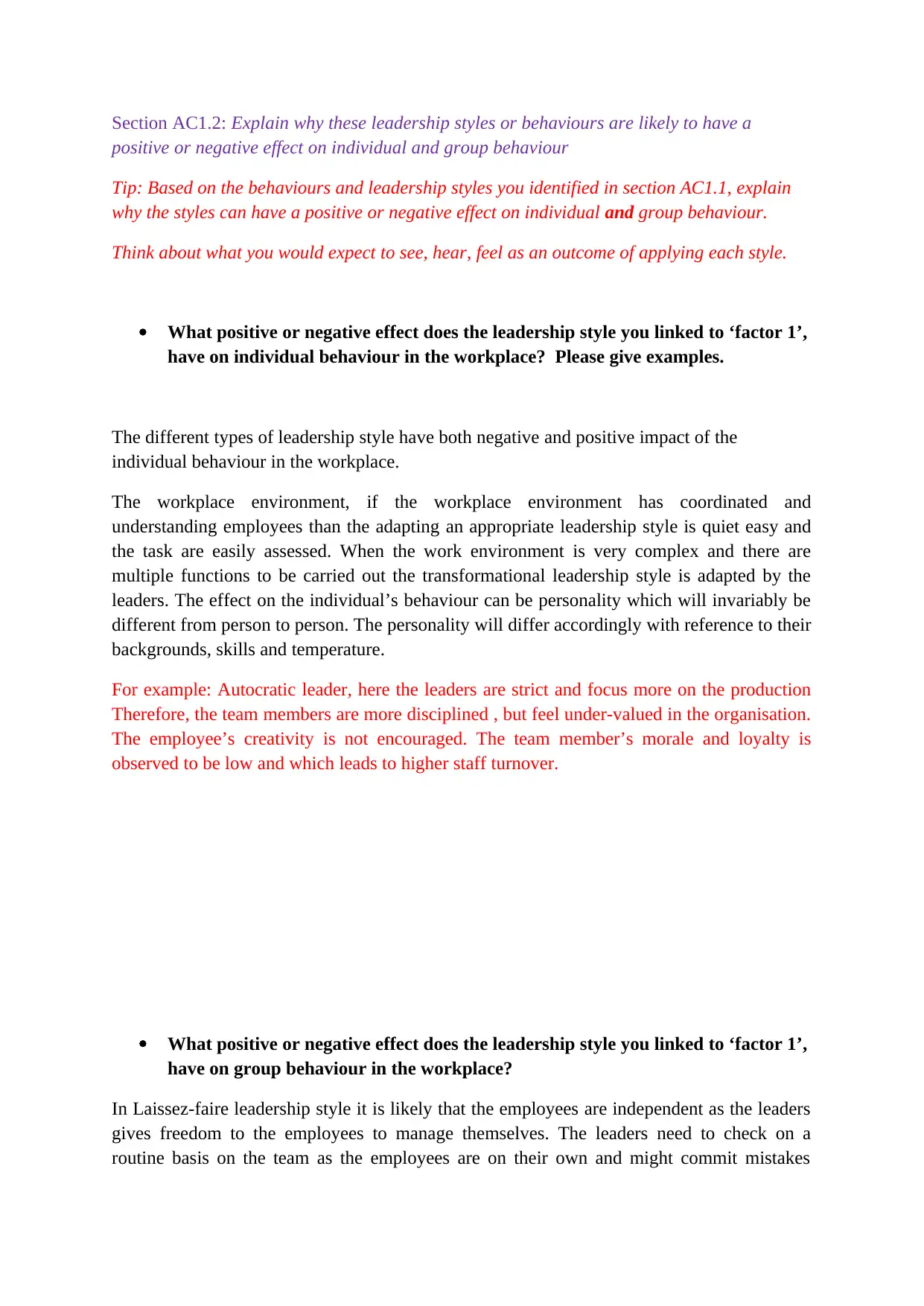
Section AC1.2: Explain why these leadership styles or behaviours are likely to have a
positive or negative effect on individual and group behaviour
Tip: Based on the behaviours and leadership styles you identified in section AC1.1, explain
why the styles can have a positive or negative effect on individual and group behaviour.
Think about what you would expect to see, hear, feel as an outcome of applying each style.
What positive or negative effect does the leadership style you linked to ‘factor 1’,
have on individual behaviour in the workplace? Please give examples.
The different types of leadership style have both negative and positive impact of the
individual behaviour in the workplace.
The workplace environment, if the workplace environment has coordinated and
understanding employees than the adapting an appropriate leadership style is quiet easy and
the task are easily assessed. When the work environment is very complex and there are
multiple functions to be carried out the transformational leadership style is adapted by the
leaders. The effect on the individual’s behaviour can be personality which will invariably be
different from person to person. The personality will differ accordingly with reference to their
backgrounds, skills and temperature.
For example: Autocratic leader, here the leaders are strict and focus more on the production
Therefore, the team members are more disciplined , but feel under-valued in the organisation.
The employee’s creativity is not encouraged. The team member’s morale and loyalty is
observed to be low and which leads to higher staff turnover.
What positive or negative effect does the leadership style you linked to ‘factor 1’,
have on group behaviour in the workplace?
In Laissez-faire leadership style it is likely that the employees are independent as the leaders
gives freedom to the employees to manage themselves. The leaders need to check on a
routine basis on the team as the employees are on their own and might commit mistakes
positive or negative effect on individual and group behaviour
Tip: Based on the behaviours and leadership styles you identified in section AC1.1, explain
why the styles can have a positive or negative effect on individual and group behaviour.
Think about what you would expect to see, hear, feel as an outcome of applying each style.
What positive or negative effect does the leadership style you linked to ‘factor 1’,
have on individual behaviour in the workplace? Please give examples.
The different types of leadership style have both negative and positive impact of the
individual behaviour in the workplace.
The workplace environment, if the workplace environment has coordinated and
understanding employees than the adapting an appropriate leadership style is quiet easy and
the task are easily assessed. When the work environment is very complex and there are
multiple functions to be carried out the transformational leadership style is adapted by the
leaders. The effect on the individual’s behaviour can be personality which will invariably be
different from person to person. The personality will differ accordingly with reference to their
backgrounds, skills and temperature.
For example: Autocratic leader, here the leaders are strict and focus more on the production
Therefore, the team members are more disciplined , but feel under-valued in the organisation.
The employee’s creativity is not encouraged. The team member’s morale and loyalty is
observed to be low and which leads to higher staff turnover.
What positive or negative effect does the leadership style you linked to ‘factor 1’,
have on group behaviour in the workplace?
In Laissez-faire leadership style it is likely that the employees are independent as the leaders
gives freedom to the employees to manage themselves. The leaders need to check on a
routine basis on the team as the employees are on their own and might commit mistakes
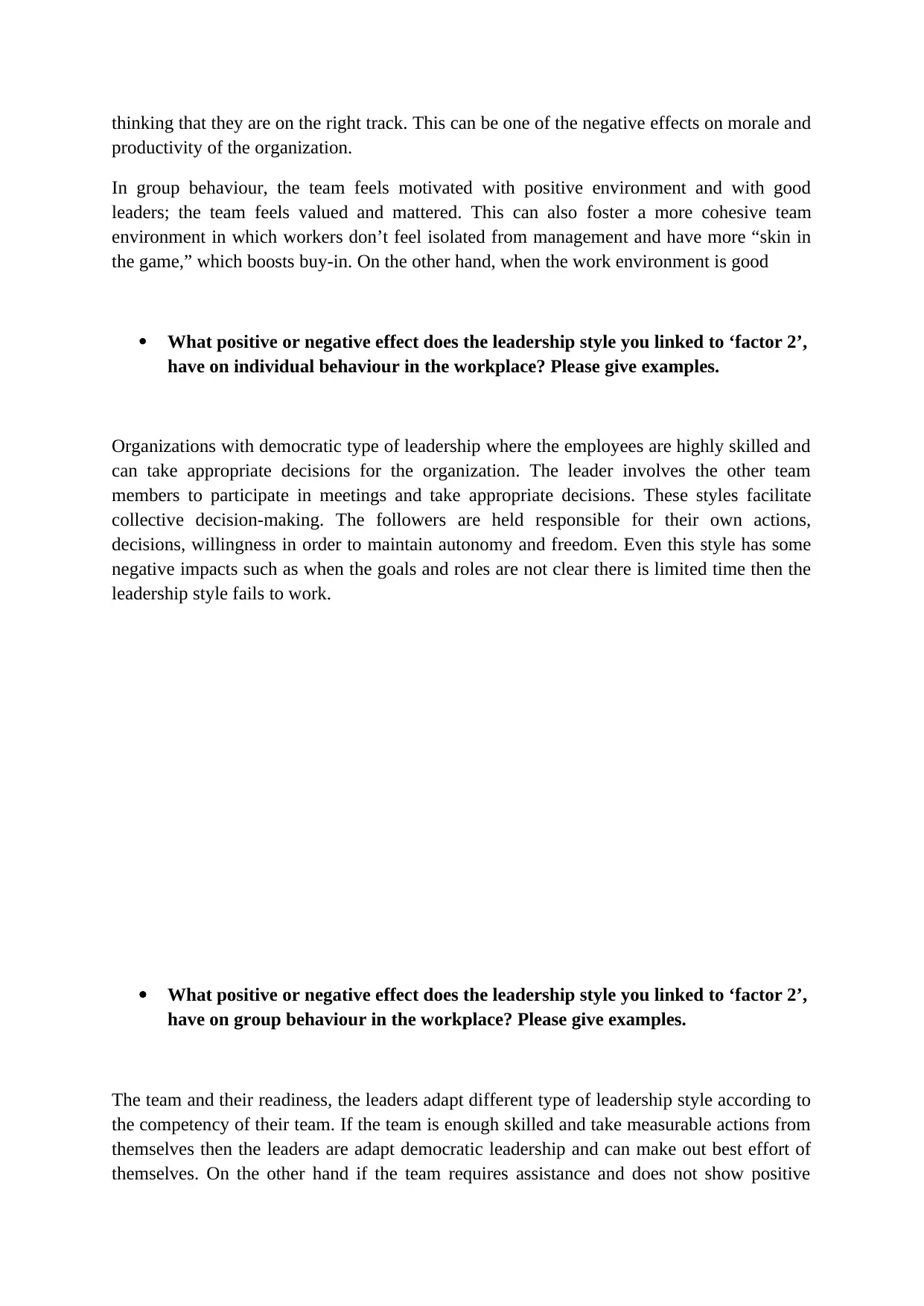
thinking that they are on the right track. This can be one of the negative effects on morale and
productivity of the organization.
In group behaviour, the team feels motivated with positive environment and with good
leaders; the team feels valued and mattered. This can also foster a more cohesive team
environment in which workers don’t feel isolated from management and have more “skin in
the game,” which boosts buy-in. On the other hand, when the work environment is good
What positive or negative effect does the leadership style you linked to ‘factor 2’,
have on individual behaviour in the workplace? Please give examples.
Organizations with democratic type of leadership where the employees are highly skilled and
can take appropriate decisions for the organization. The leader involves the other team
members to participate in meetings and take appropriate decisions. These styles facilitate
collective decision-making. The followers are held responsible for their own actions,
decisions, willingness in order to maintain autonomy and freedom. Even this style has some
negative impacts such as when the goals and roles are not clear there is limited time then the
leadership style fails to work.
What positive or negative effect does the leadership style you linked to ‘factor 2’,
have on group behaviour in the workplace? Please give examples.
The team and their readiness, the leaders adapt different type of leadership style according to
the competency of their team. If the team is enough skilled and take measurable actions from
themselves then the leaders are adapt democratic leadership and can make out best effort of
themselves. On the other hand if the team requires assistance and does not show positive
productivity of the organization.
In group behaviour, the team feels motivated with positive environment and with good
leaders; the team feels valued and mattered. This can also foster a more cohesive team
environment in which workers don’t feel isolated from management and have more “skin in
the game,” which boosts buy-in. On the other hand, when the work environment is good
What positive or negative effect does the leadership style you linked to ‘factor 2’,
have on individual behaviour in the workplace? Please give examples.
Organizations with democratic type of leadership where the employees are highly skilled and
can take appropriate decisions for the organization. The leader involves the other team
members to participate in meetings and take appropriate decisions. These styles facilitate
collective decision-making. The followers are held responsible for their own actions,
decisions, willingness in order to maintain autonomy and freedom. Even this style has some
negative impacts such as when the goals and roles are not clear there is limited time then the
leadership style fails to work.
What positive or negative effect does the leadership style you linked to ‘factor 2’,
have on group behaviour in the workplace? Please give examples.
The team and their readiness, the leaders adapt different type of leadership style according to
the competency of their team. If the team is enough skilled and take measurable actions from
themselves then the leaders are adapt democratic leadership and can make out best effort of
themselves. On the other hand if the team requires assistance and does not show positive
⊘ This is a preview!⊘
Do you want full access?
Subscribe today to unlock all pages.

Trusted by 1+ million students worldwide
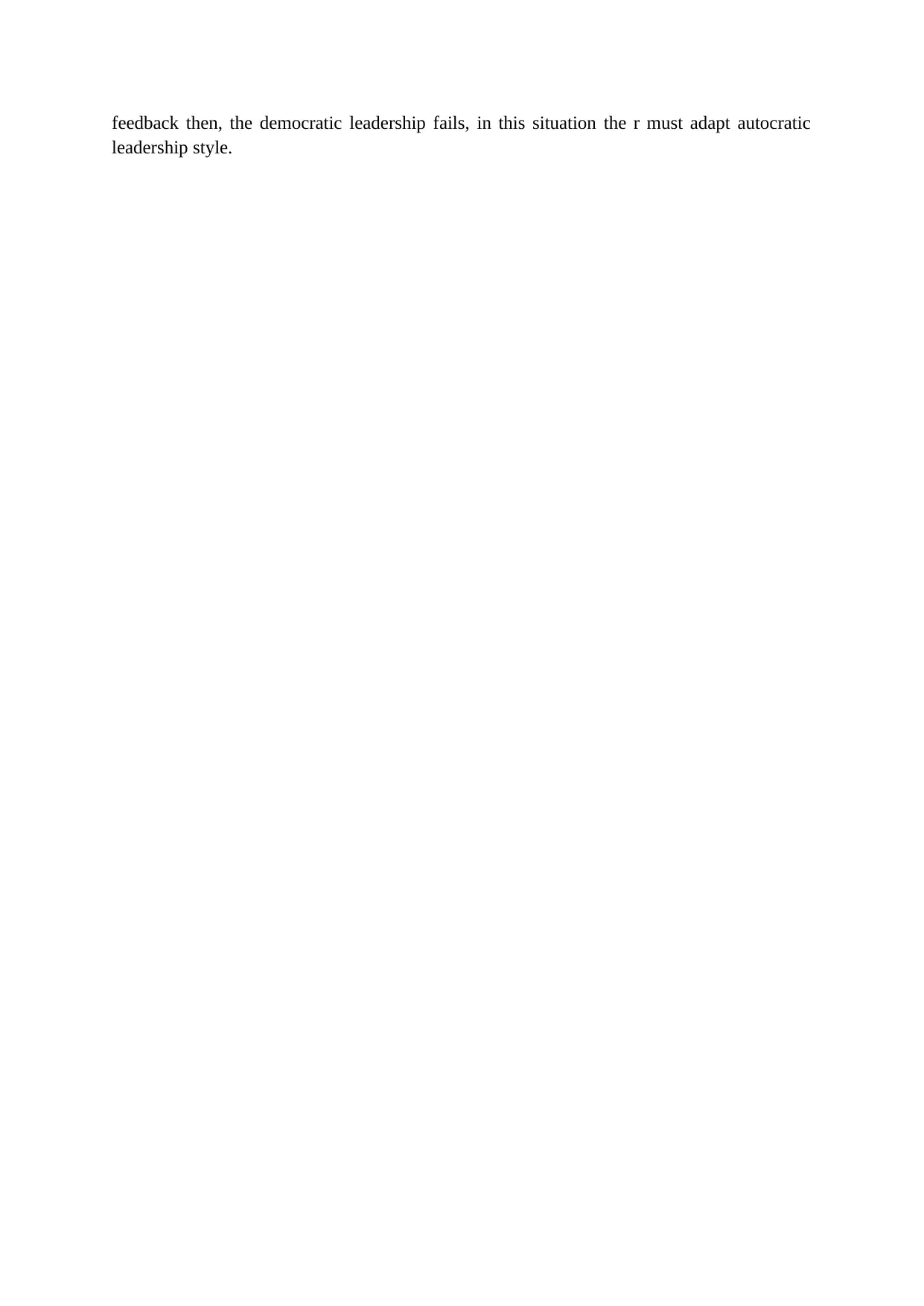
feedback then, the democratic leadership fails, in this situation the r must adapt autocratic
leadership style.
leadership style.
Paraphrase This Document
Need a fresh take? Get an instant paraphrase of this document with our AI Paraphraser
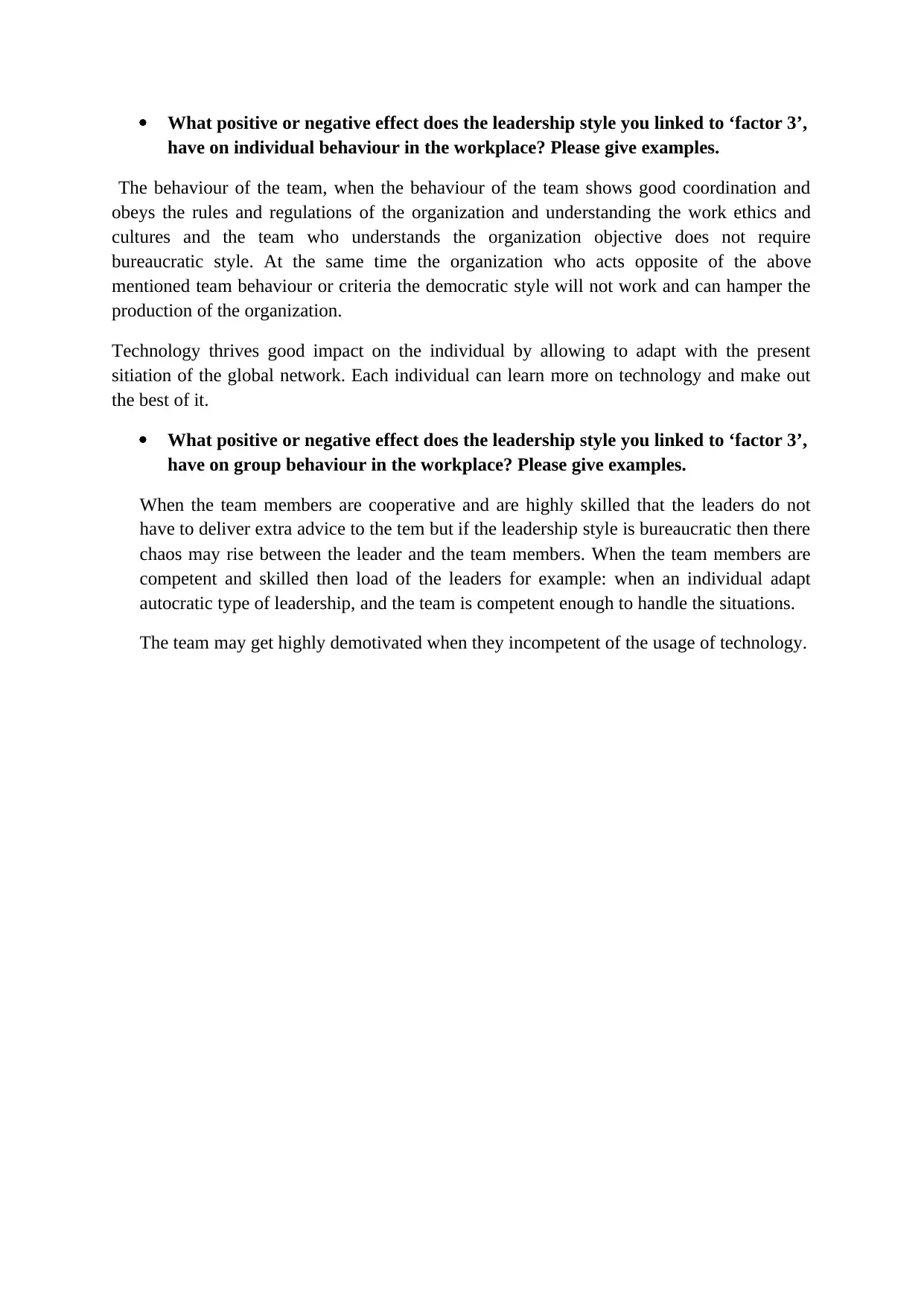
What positive or negative effect does the leadership style you linked to ‘factor 3’,
have on individual behaviour in the workplace? Please give examples.
The behaviour of the team, when the behaviour of the team shows good coordination and
obeys the rules and regulations of the organization and understanding the work ethics and
cultures and the team who understands the organization objective does not require
bureaucratic style. At the same time the organization who acts opposite of the above
mentioned team behaviour or criteria the democratic style will not work and can hamper the
production of the organization.
Technology thrives good impact on the individual by allowing to adapt with the present
sitiation of the global network. Each individual can learn more on technology and make out
the best of it.
What positive or negative effect does the leadership style you linked to ‘factor 3’,
have on group behaviour in the workplace? Please give examples.
When the team members are cooperative and are highly skilled that the leaders do not
have to deliver extra advice to the tem but if the leadership style is bureaucratic then there
chaos may rise between the leader and the team members. When the team members are
competent and skilled then load of the leaders for example: when an individual adapt
autocratic type of leadership, and the team is competent enough to handle the situations.
The team may get highly demotivated when they incompetent of the usage of technology.
have on individual behaviour in the workplace? Please give examples.
The behaviour of the team, when the behaviour of the team shows good coordination and
obeys the rules and regulations of the organization and understanding the work ethics and
cultures and the team who understands the organization objective does not require
bureaucratic style. At the same time the organization who acts opposite of the above
mentioned team behaviour or criteria the democratic style will not work and can hamper the
production of the organization.
Technology thrives good impact on the individual by allowing to adapt with the present
sitiation of the global network. Each individual can learn more on technology and make out
the best of it.
What positive or negative effect does the leadership style you linked to ‘factor 3’,
have on group behaviour in the workplace? Please give examples.
When the team members are cooperative and are highly skilled that the leaders do not
have to deliver extra advice to the tem but if the leadership style is bureaucratic then there
chaos may rise between the leader and the team members. When the team members are
competent and skilled then load of the leaders for example: when an individual adapt
autocratic type of leadership, and the team is competent enough to handle the situations.
The team may get highly demotivated when they incompetent of the usage of technology.
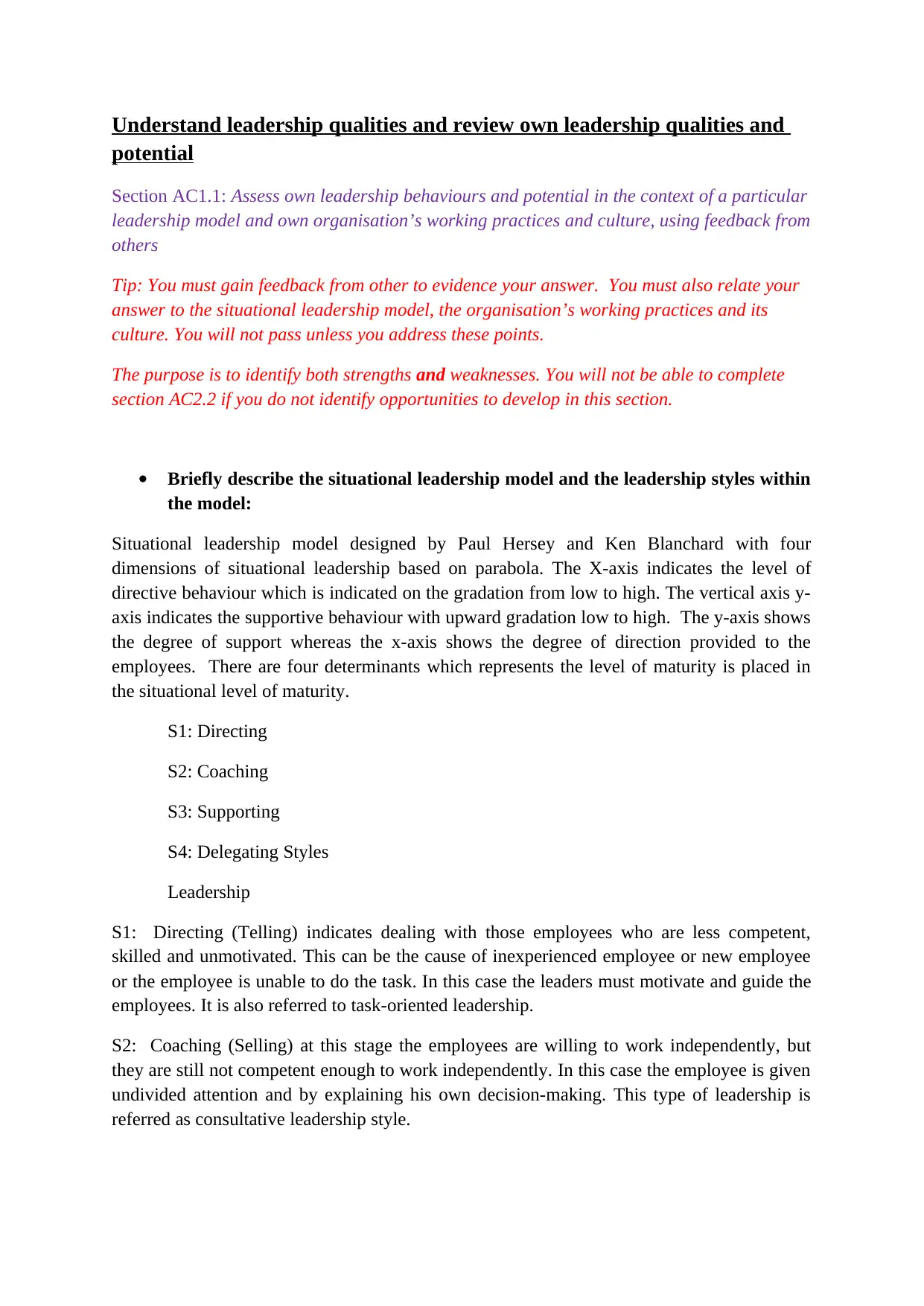
Understand leadership qualities and review own leadership qualities and
potential
Section AC1.1: Assess own leadership behaviours and potential in the context of a particular
leadership model and own organisation’s working practices and culture, using feedback from
others
Tip: You must gain feedback from other to evidence your answer. You must also relate your
answer to the situational leadership model, the organisation’s working practices and its
culture. You will not pass unless you address these points.
The purpose is to identify both strengths and weaknesses. You will not be able to complete
section AC2.2 if you do not identify opportunities to develop in this section.
Briefly describe the situational leadership model and the leadership styles within
the model:
Situational leadership model designed by Paul Hersey and Ken Blanchard with four
dimensions of situational leadership based on parabola. The X-axis indicates the level of
directive behaviour which is indicated on the gradation from low to high. The vertical axis y-
axis indicates the supportive behaviour with upward gradation low to high. The y-axis shows
the degree of support whereas the x-axis shows the degree of direction provided to the
employees. There are four determinants which represents the level of maturity is placed in
the situational level of maturity.
S1: Directing
S2: Coaching
S3: Supporting
S4: Delegating Styles
Leadership
S1: Directing (Telling) indicates dealing with those employees who are less competent,
skilled and unmotivated. This can be the cause of inexperienced employee or new employee
or the employee is unable to do the task. In this case the leaders must motivate and guide the
employees. It is also referred to task-oriented leadership.
S2: Coaching (Selling) at this stage the employees are willing to work independently, but
they are still not competent enough to work independently. In this case the employee is given
undivided attention and by explaining his own decision-making. This type of leadership is
referred as consultative leadership style.
potential
Section AC1.1: Assess own leadership behaviours and potential in the context of a particular
leadership model and own organisation’s working practices and culture, using feedback from
others
Tip: You must gain feedback from other to evidence your answer. You must also relate your
answer to the situational leadership model, the organisation’s working practices and its
culture. You will not pass unless you address these points.
The purpose is to identify both strengths and weaknesses. You will not be able to complete
section AC2.2 if you do not identify opportunities to develop in this section.
Briefly describe the situational leadership model and the leadership styles within
the model:
Situational leadership model designed by Paul Hersey and Ken Blanchard with four
dimensions of situational leadership based on parabola. The X-axis indicates the level of
directive behaviour which is indicated on the gradation from low to high. The vertical axis y-
axis indicates the supportive behaviour with upward gradation low to high. The y-axis shows
the degree of support whereas the x-axis shows the degree of direction provided to the
employees. There are four determinants which represents the level of maturity is placed in
the situational level of maturity.
S1: Directing
S2: Coaching
S3: Supporting
S4: Delegating Styles
Leadership
S1: Directing (Telling) indicates dealing with those employees who are less competent,
skilled and unmotivated. This can be the cause of inexperienced employee or new employee
or the employee is unable to do the task. In this case the leaders must motivate and guide the
employees. It is also referred to task-oriented leadership.
S2: Coaching (Selling) at this stage the employees are willing to work independently, but
they are still not competent enough to work independently. In this case the employee is given
undivided attention and by explaining his own decision-making. This type of leadership is
referred as consultative leadership style.
⊘ This is a preview!⊘
Do you want full access?
Subscribe today to unlock all pages.

Trusted by 1+ million students worldwide
1 out of 28
Related Documents
Your All-in-One AI-Powered Toolkit for Academic Success.
+13062052269
info@desklib.com
Available 24*7 on WhatsApp / Email
![[object Object]](/_next/static/media/star-bottom.7253800d.svg)
Unlock your academic potential
Copyright © 2020–2025 A2Z Services. All Rights Reserved. Developed and managed by ZUCOL.



